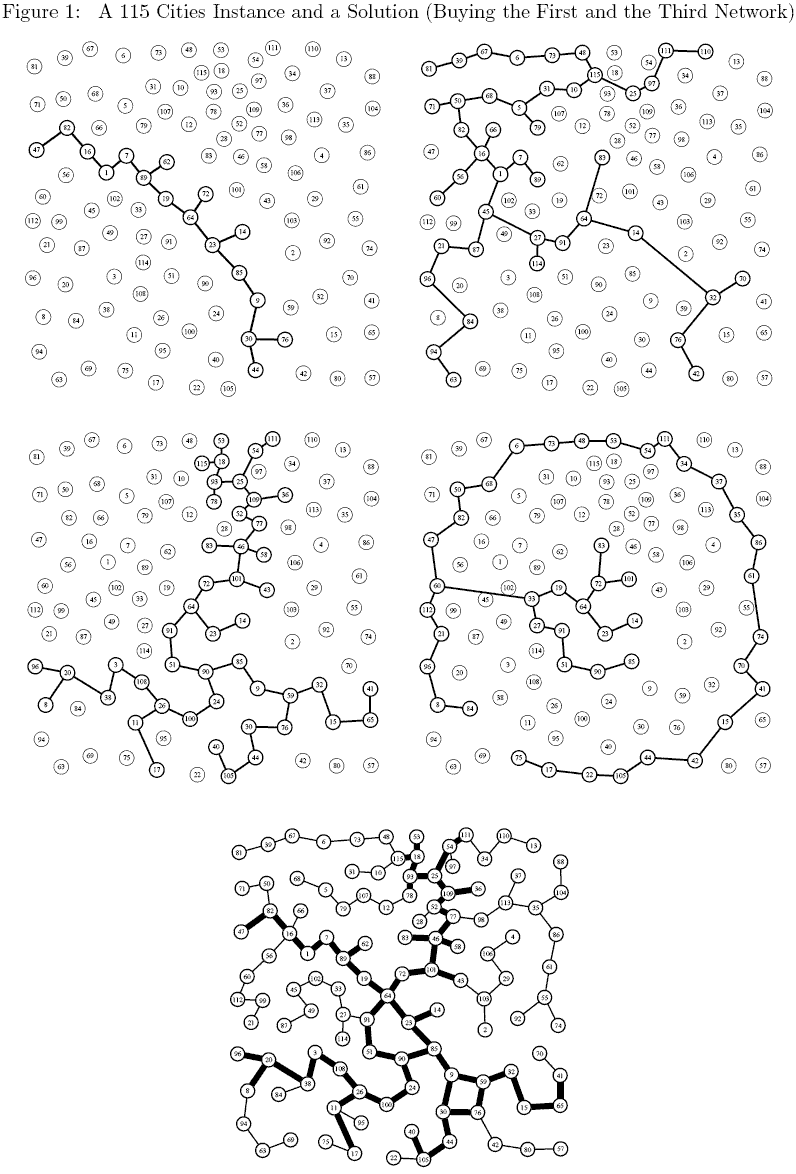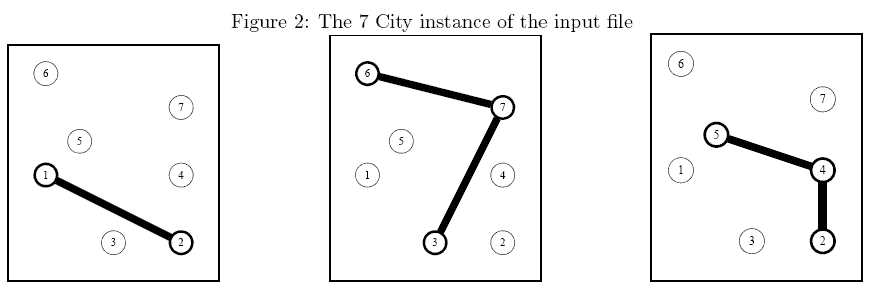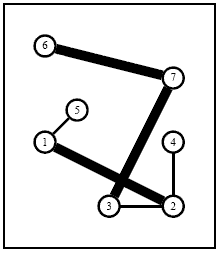Buy or Build (poj 2784 最小生成树)
| Time Limit: 2000MS | Memory Limit: 65536K | |
| Total Submissions: 1348 | Accepted: 533 |
Description
and which is now seeking for investments of international companies (for a complete description of Borduria, have a look to the following Tintin albums ``King Ottokar's Sceptre", ``The Calculus Affair" and ``Tintin and the Picaros"). You are requested to help
WWN todecide how to setup its network for a minimal total cost.
Problem
There are several local companies running small networks (called subnetworks in the following) that partially cover the n largest cities of Borduria. WWN would like to setup a network that connects all n cities. To achieve this, it can either build edges between
cities from scratch or it can buy one or several subnetworks from local companies. You are requested to help WWN to decide how to setup its network for a minimal total cost.
- All n cities are located by their two-dimensional Cartesian coordinates.
- There are q existing subnetworks. If q>=1 then each subnetwork c ( 1<=c<=q ) is defined by a set of interconnected cities (the exact shape of a subnetwork is not relevant to our problem).
- A subnetwork c can be bought for a total cost wc and it cannot be split (i.e., the network cannot be fractioned).
- To connect two cities that are not connected through the subnetworks bought, WWN has to build an edge whose cost is exactly the square of the Euclidean distance between the cities.
You have to decide which existing networks you buy and which edges you setup so that the total cost is minimal. Note that the number of existing networks is always very small (typically smaller than 8).
A 115 Cities Instance
Consider a 115 cities instance of the problem with 4 subnetworks (the 4 first graphs in Figure 1). As mentioned earlier the exact shape of a subnetwork is not relevant still, to keep figures easy to read, we have assumed an arbitrary tree like structure for
each subnetworks. The bottom network in Figure 1 corresponds to the solution in which the first and the third networks have been bought. Thin edges correspond to edges build from scratch while thick edges are those from one of the initial networks.
Input
followed by q lines (one per subnetwork), all of them following the same pattern: The first integer is the number of cities in the subnetwork. The second integer is the the cost of the subnetwork (not greater than 2 x 106 ). The remaining integers
on the line (as many as the number of cities in the subnetwork) are the identifiers of the cities in the subnetwork. The last part of the file contains n lines that provide the coordinates of the cities (city 1 on the first line, city 2 on the second one,
etc). Each line is made of 2 integer values (ranging from 0 to 3000) corresponding to the integer coordinates of the city.
Output
Sample Input
7 3
2 4 1 2
3 3 3 6 7
3 9 2 4 5
0 2
4 0
2 0
4 2
1 3
0 5
4 4
Sample Output
17
Hint


Figure 3: An optimal solution of the 7 City instance in which which the first and second existing networkshave been bought while two extra edges (1, 5) and (2, 4)

Source
题意:n个城市,告诉每一个城市的坐标,还有q个联通块,如今要把这n个城市连起来,能够购买联通块(每一个有一定的费用),或者新建一条边(费用为点之间的距离的平方)。问最小费用是多少。
思路:q非常小。二进制枚举选哪些块。每次kruskal一遍,求最小值。
代码:
#include <iostream>
#include <cstdio>
#include <cstring>
#include <algorithm>
#include <cmath>
#include <string>
#include <map>
#include <stack>
#include <vector>
#include <set>
#include <queue>
#pragma comment (linker,"/STACK:102400000,102400000")
#define mod 1000000009
#define INF 0x3f3f3f3f
#define pi acos(-1.0)
#define eps 1e-6
#define lson rt<<1,l,mid
#define rson rt<<1|1,mid+1,r
#define FRE(i,a,b) for(i = a; i <= b; i++)
#define FREE(i,a,b) for(i = a; i >= b; i--)
#define FRL(i,a,b) for(i = a; i < b; i++)
#define FRLL(i,a,b) for(i = a; i > b; i--)
#define mem(t, v) memset ((t) , v, sizeof(t))
#define sf(n) scanf("%d", &n)
#define sff(a,b) scanf("%d %d", &a, &b)
#define sfff(a,b,c) scanf("%d %d %d", &a, &b, &c)
#define pf printf
#define DBG pf("Hi\n")
typedef long long ll;
using namespace std; const int maxn = 1005;
const int MAXN = 500500; struct Node
{
int x,y;
}node[maxn]; struct Edge
{
int u,v,len;
bool operator<(const Edge &a)const
{
return len<a.len;
}
}edge[MAXN]; int father[maxn],cost[10];
int n,q,num;
vector<int>g[10]; void init()
{
for (int i=0;i<=n;i++)
father[i]=i;
} void addedge(int u,int v)
{
edge[num].u=u;
edge[num].v=v;
edge[num++].len=(node[u].x-node[v].x)*(node[u].x-node[v].x)+(node[u].y-node[v].y)*(node[u].y-node[v].y);
} int find_father(int x)
{
if (x!=father[x])
father[x]=find_father(father[x]);
return father[x];
} bool Union(int a,int b)
{
int fa=find_father(a);
int fb=find_father(b);
if (fa==fb) return false;
father[fa]=fb;
return true;
} int Kruskal()
{
int ans=0;
int cnt=0;
for (int i=0;i<num;i++)
{
if (Union(edge[i].u,edge[i].v))
{
ans+=edge[i].len;
cnt++;
}
if (cnt==n-1) break;
}
return ans;
} void solve()
{
init();
int ans=Kruskal();
for (int i=0;i<(1<<q);i++)
{
init();
int all=0;
for (int j=0;j<q;j++)
{
if (!((i>>j)&1)) continue;
all+=cost[j];
for (int k=1;k<g[j].size();k++)
Union(g[j][k],g[j][0]);
}
ans=min(ans,all+Kruskal());
}
pf("%d\n",ans);
} int main()
{
int i,j,t,number,x;
// sf(t);
// while (t--)
{
sff(n,q);
num=0;
for (i=0;i<q;i++)
{
g[i].clear();
sff(number,cost[i]);
for (j=0;j<number;j++)
{
sf(x);
g[i].push_back(x);
}
}
for (i=1;i<=n;i++)
sff(node[i].x,node[i].y);
for (i=1;i<=n;i++)
for (j=i+1;j<=n;j++)
addedge(i,j);
sort(edge,edge+num);
solve();
// if (t) puts("");
}
return 0;
}
/*
1 7 3
2 4 1 2
3 3 3 6 7
3 9 2 4 5
0 2
4 0
2 0
4 2
1 3
0 5
4 4
*/
Buy or Build (poj 2784 最小生成树)的更多相关文章
- uva 1151 - Buy or Build poj 2784 Buy or Build(最小生成树)
最小生成树算法简单 只是增加了一些新的东西,对于需要最小生成树算法 和中 并检查使用的一系列 还有一些更深入的了解. 方法的一些复杂问题 #include<cstdio> #include ...
- UVA 1151 Buy or Build (MST最小生成树,kruscal,变形)
题意: 要使n个点之间能够互通,要使两点直接互通需要耗费它们之间的欧几里得距离的平方大小的花费,这说明每两个点都可以使其互通.接着有q个套餐可以选,一旦选了这些套餐,他们所包含的点自动就连起来了,所需 ...
- 【uva 1151】Buy or Build(图论--最小生成树+二进制枚举状态)
题意:平面上有N个点(1≤N≤1000),若要新建边,费用是2点的欧几里德距离的平方.另外还有Q个套餐,每个套餐里的点互相联通,总费用为Ci.问让所有N个点连通的最小费用.(2组数据的输出之间要求有换 ...
- POJ(2784)Buy or Build
Buy or Build Time Limit: 2000MS Memory Limit: 65536K Total Submissions: 1369 Accepted: 542 Descr ...
- Poj(2784),二进制枚举最小生成树
题目链接:http://poj.org/problem?id=2784 Buy or Build Time Limit: 2000MS Memory Limit: 65536K Total Sub ...
- UVA 1151 Buy or Build MST(最小生成树)
题意: 在平面上有n个点,要让所有n个点都连通,所以你要构造一些边来连通他们,连通的费用等于两个端点的欧几里得距离的平方.另外还有q个套餐,可以购买,如果你购买了第i个套餐,该套餐中的所有结点将变得相 ...
- UVA 1151 Buy or Build (最小生成树)
先求出原图的最小生成树,然后枚举买哪些套餐,把一个套餐内的点相互之间边权为0,直接用并查集缩点.正确性是基于一个贪心, 在做Kruskal算法是,对于没有进入最小生成树的边,排序在它前面的边不会减少. ...
- 【UVA 1151】 Buy or Build (有某些特别的东东的最小生成树)
[题意] 平面上有n个点(1<=N<=1000),你的任务是让所有n个点连通,为此,你可以新建一些边,费用等于两个端点的欧几里得距离的平方. 另外还有q(0<=q<=8)个套餐 ...
- 【最小生成树+子集枚举】Uva1151 Buy or Build
Description 平面上有n个点(1<=N<=1000),你的任务是让所有n个点连通,为此,你可以新建一些边,费用等于两个端点的欧几里得距离的平方. 另外还有q(0<=q< ...
随机推荐
- Elasticsearch之sense插件的安装(图文详解)
sense插件可以方便的执行rest请求,但是中文输入的体验不是很好. 安装sense只需要在Kibana端安装插件即可,插件会自动安装到kibana的应用菜单中. [hadoop@master ki ...
- Mybatis的Dao向mapper传多个参数(三种解决方案)
第一种方案 : DAO层的函数方法 Public User selectUser(String name,String area); 对应的Mapper.xml <select id=" ...
- 将class类对象转化成json的数据格式
直接上代码: JSONObject的的使用需要导入json-lib-2.4-jdk15.jar包,下载地址:http://mvnrepository.com/artifact/net.sf.json- ...
- OFDM同步算法之Schmidl算法
Schmidl算法代码 算法原理 训练序列结构 T=[A A],其中A表示复伪随机序列PN,进行N/2点ifft变换得到的符号序列 \[M(d)=\frac{\left | P(d) \right | ...
- logstash windows下添加服务启动管理
nssm下载链接:http://nssm.cc/release/nssm-2.24.zip
- ACM蓝桥杯之换硬币问题
题目描述: 想兑换100元零钱,有1元.2元.5元.10元四种面值,总有多少种兑换方法? 解题思路: 本题可以采用多种方法求解.最容易理解的应该就是暴力穷举和递归求解.那么本文主要介绍这两种解法. 暴 ...
- Cashier (codeforces 1059A)
题目倒是不难注意第一个时间段可能不是从零开始的,所以注意第一个时间的开始节点与零之间可能存在休息的时间 还有这个题我打的时候一直谜之RE......发现原来bool函数忘记写return了.....以 ...
- 13.multi_match实现dis_max+tie_breaker
主要知识点: 基于multi_match语法实现dis_max+tie_breaker 1.best_fields+tie_breaker GET /forum/article/_search ...
- Ac自动机基础题集合
Ac_automaton的板子打熟以后发现碰到题不会做,而且还是比较纯的板子,只要改几处地方就可以,Ac_automation有许多优秀而fantasy的性质,下面粘几个题,来记录一下做题的心得. 1 ...
- 【codeforces 766E】Mahmoud and a xor trip
[题目链接]:http://codeforces.com/contest/766/problem/E [题意] 定义树上任意两点之间的距离为这条简单路径上经过的点; 那些点上的权值的所有异或; 求任意 ...
